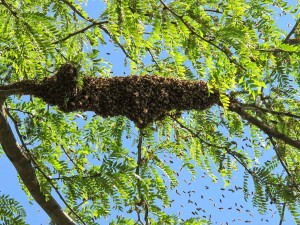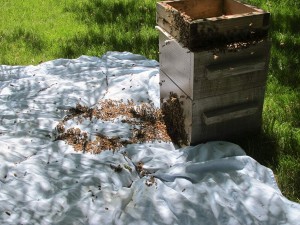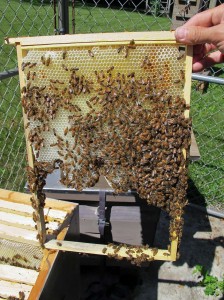Larry, the excentric beekeeper in Indiana, shares with me many of his experiences. Here’s one I share with you readers:
Friday afternoon, 23 May, I just happened to be present at the beginning of a prime swarm cast from my Warré Box Hive Project.
(http://www.eccentricbeekeeper.com/hives/boxhive.html ) The existing hive has double deep frames with small cell comb with cells ranging from 4.7 mm to 5.0 mm. I placed the swarm in a second Warré sized hive with eight of my double deep foundationless frames. It will be interesting to measure the comb drawn by the swarm in the new hive once it is firm enough to handle.
The swarm was hived at the peak of a strong black locust, Robinia pseudoacacia, nectar flow. When I checked the colony on Tuesday, 27 May, the bees had drawn comb in all eight frames down to the skewer/spale located eight inches from the top.
I checked the colony in the morning 31 May. There was one frame of comb on the outside of the box that had a partial collapse. I think it was due to the rapid drawing of new comb, the weight of the abundant stored nectar and the 30° C afternoons. I observed the queen. She is in good condition and laying eggs.
The colony is not drawing comb as fast now as it did during the first four days which could be due to the queens laying and the added labor of pollen collection and brood rearing. However, I am still very pleased with the colony’s progress.
Nine days following the prime swarm the original colony has twice attempted an afterswarm. The first clustered on a tree branch forty feet up for about thirty minutes before returning to the hive. The next day the second filled the air and clustered on the front of the hive before reentering.
Here is a link to a video of the second attempt highlights. https://vimeo.com/97137803
I returned home from my out yard 5 June with 50 pounds of capped tulip poplar/black locust honey just in time to attend a third afterswarm. This time they were more organized than the previous attempts. I was able to place them in a hive.
I was able to cut several nice sections of comb honey from the tulip popla/ black locust honey. The rest I am crushing and straining.
Regards, Larry


